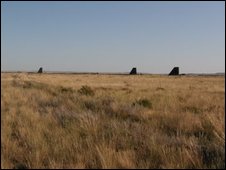Decades of Soviet nuclear testing on the steppes of Kazakhstan have been blamed for an alarming number of health problems suffered by residents in the area.
Now scientists are trying to determine whether the victims are passing on faulty genes to their children, the BBC's Rayhan Demytrie reports.
"It looked like a mushroom, it grew bigger and bigger. It felt like a small earthquake," says 70-year-old Zikesh, from the Kazakh city of Semey (called Semipalatinsk in Soviet times)."
"We were proud back then, we thought, let the Americans touch us, we will show them. We were fools, look at us now."
Zikesh is undergoing treatment for cancer. He is one of many people from this region of north-east Kazakhstan who blame years of Soviet nuclear testing for their ill health.
It began in 1949 when the Soviet Union's first atomic bomb was detonated in an area of nearby steppe known as the Polygon.
The testing continued for 40 years. Nearly 500 nuclear explosions were carried out. More than 100 of them were above-ground devices that sent nuclear fallout far beyond the test area.
At the time, thousands of people who lived within a 300,000 sq km territory surrounding the Polygon were exposed to high levels of radiation.
Saim Balmukhanov, a veteran Kazakh radiologist, was one of the first doctors to be admitted to the villages affected by radiation in the 1950s.
"We found out that leukemia among children was 10 times higher than the Soviet average and among adults it was five times higher. The Soviet authorities said it was because of the poor living conditions of the Kazakhs," he said.
"Many women in those villages were suffering from miscarriages and lots of babies were born with birth defects. But people were hiding it, because in Kazakh culture no-one would marry into such a family."
Radiation sufferers
Today, nearly half a million people have officially been recognized by the Kazakh authorities as affected by nuclear testing - for which they receive a modest disability allowance.
Thirty-year-old Berek is one of them. He was born in the village of Znamenka, which fell within the boundaries of radiation fallout.
His face has been disfigured by a malignant tumor. The tumor was removed 10 years ago when a visiting Italian journalist raised funds for Berek to be treated in Italy.
But within six months the skin started growing again. It hangs over his nose and mouth and makes it difficult for Berek to speak.
"I dream of being able to tell the difference between night and day. I wish I could see what my mother looks like," says Berek, as he pulls out a national Kazakh instrument to sing a song.
There are many stories like Berek's. But not all who claim to have suffered from radiation can get official recognition.
Proving the link
"It's a lengthy process. One has to provide so many papers to prove the link," complains Dariga Murzabekova who is receiving treatment in Semey's Institute of Radiation Medicine.
"My mother also had two strokes, she died after the second one," she said.
"So maybe I inherited this from my mum. My grandmother and grandfather both died from cancer. They were from Abai region, close to the Polygon."
And this is what scientists now are trying to understand - whether children born to parents or grandparents who were exposed to radiation have inherited faulty genes damaged by nuclear testing.
A new lab equipped with modern technology at the Institute of Radiation Medicine is allowing scientists for the first time to carry out such DNA research.
"There are new methods of studying the humane genome, it is not that we will be able to predict mutations, but it is possible to predict susceptibility to certain illnesses in the last stages of fetal development," says Galina Bilyalova, a research scientist at the institute.
But there are those who think that the effects of radiation have been exaggerated.
Yuri Strelchuk, from the Kazakh Radiation Safety Institute, argues that the health problems of today are not related to nuclear tests that ended in 1989.
"It is so convenient to have this one cause which everything can be blamed on," he said.
"If you look at living conditions in villages close to the Polygon, they have big problems with hygiene, poor living conditions, there is no clean water, people don't eat well because not much grows in this area."
National statistics show that eastern Kazakhstan region has one of the highest mortality rates in the country.
Cancer is one-and-a-half times more prevalent here than in the rest of Kazakhstan.
Dr Nurmagambetov, of a regional pre-natal clinic, says no more proof is needed to demonstrate the impact of radiation on public health in Semey.
"Yes birth defects, cancer and other health problems exist everywhere in the world, the only difference is that here it happens twice as much," he said.
"If I lost half of my family to cancer - and I see every day children being born with complexities - what else is there to blame than the Polygon?"
PHOTO CAPTION
The site where the Soviet Union's first atomic bomb was detonated
BBC


 Home
Home Discover Islam
Discover Islam Quran Recitations
Quran Recitations Lectures
Lectures
 Fatwa
Fatwa Articles
Articles Fiqh
Fiqh E-Books
E-Books Boys & Girls
Boys & Girls  Articles
Articles










